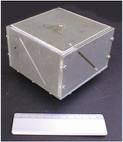LTG Elettronica


ANTENNA SYSTEMS

REVERSE ENGINEERING

Many military systems depend from components and subassemblies based on technologies in use in ‘60. These components were built by manufacturers in many cases that no longer exist, so is very difficult to find support documentation. In order to resolve this problem, LTG has adopted a series of strategies.
A first strategy is the reconstruction of the component or assembly. To such scope, LTG has a large experience in the field of reverse engineering. This choice allow to supply FFF (Fit, Form, and Function) components and subassembly, equivalents to the originals. On the other hand, the logistical support to the defense system is guaranteed for several years, thanks to modernized, upgraded and high reliability components.
A second strategy, when the precedent is not practicable (for reasons of complexity or cost) is to acquire a commercial grade component (COTS) and to proceed to upscreen it to MIL qualification Also in this field LTG is in a position to offer all the necessary resources to the qualification process.

Integrated Circuits Visual Inspection
LTG has inherited a great experience in the field of antenna systems. Our experience is based in the field of Antennas and Microwaves. Please ask for any information.

ARISS antenna prototype
Best view with Safari
Designed with iWeb
Last update: 24/09/2021
Copyright (c) 2011 - 2021
LTG Elettronica S.r.l. - Rome (ITALY)
EC (VAT) - IT06911371000
RAMS

Reliability, Availability, Maintainability, Safety. These four disciplines constitutes the “RAMS”, nowadays also called Dependability and Safety. RAMS activities are performed in cooperation with the design teams and engineering specialists. Our experience covers several fields:
· Worst Case Analysis
· Parts Stress Analysis
· Reliability Prediction (reliability, Mean Time Between Failures)
· Failure Modes, Effects and Criticality Analysis (FMECA)
· Analysis of failure propagation
· Fault Tree Analysis
· Failure Isolation, Detection and Correction (FDIR) Analysis
· Software Criticality Analysis
COMPONENT TESTS

LTG is in a position to facing with various strategies the problem of electronic components testing, thanks to more than decennial experience in the fields of space and defense. The most important capabilities are:
· Component Screening, Characterization, Qualification as per MIL-STD
· Parametric and Functional tests
· Burn-in Test
· Temperature Cycling
· Quality Inspection (visual, radiographic)
· Life/Reliability Characterization Tests
· Total Ionizing Dose (TID)
Total Ionizing Dose (TID) test can be performed according to MIL-STD-883 (meth. 1019) or to ESA/SCC standards, upon request of the customer. It’s possible to perform TID tests non only on single components, but also on complete electronic units, with real-time parameter monitoring. ELDRS (Enhanced Low Dose Rate Sensitivity) tests can be performed (if required) to investigate bipolar technologies devices performances. The annealing steps, thanks to our climatic chamber, are “in-house” performed. Please ask for any information.
SEMICONDUCTOR TEST SYSTEMS

Parametric measurements are generally divided into parametric DC, AC, and functional measurements. LTG covers all these measurements with the following test systems.
DC MEASUREMENTS
DC measurements measure the DC current vs voltage (I-V). Parameter evaluation is based on I-V curves (eg. threshold voltage, breakdown voltage, leakage current).
LTG has a refurbished HP4142B, complete with a series of plug-ins: 200V/1A, 100V/100mA, AFU. A Tektronix 577 with the 177 and 178 fixtures is used in the laboratory for a first, quick check of the components.
DC, AC, FUNCTIONAL
AC measurements evaluate the dynamic characteristics of the semiconductor device. With a digital IC, timing measurements such as rise time, propagation delay, setup and hold time are the primary ones, so timing resolution is important. Determining the AC gain characteristics of linear ICs require a wide dynamic range over a wide frequency band.
Functional testing evaluates the input/output operation and digital characteristics of semiconductor devices, especially logical devices such as microprocessors, memories. This measurement creates an input/output truth table (test vectors) and determines wheter the desired output is attained or not.
LTG has a refurbished HP 81810S Design Verification System (IC-DVS), capable of 50MHz, 32/64 bit wide vector memory, and 100ps timing, 10 mV level resolution. System integrates an HP4141B DC Source/Monitor with four SMUs having a 100uV - 100V voltage range, and 50fA - 100mA current range. System software for the IC-DVS was upgraded by LTG from the HP series 9000 workstations to run under Labview™.

Linear Integrated Circuit being evaluated with the Tektronix 577/178

HP 81810S IC Design Verification System during rack integration with other system components

Tracking Radar re-engineered modules




